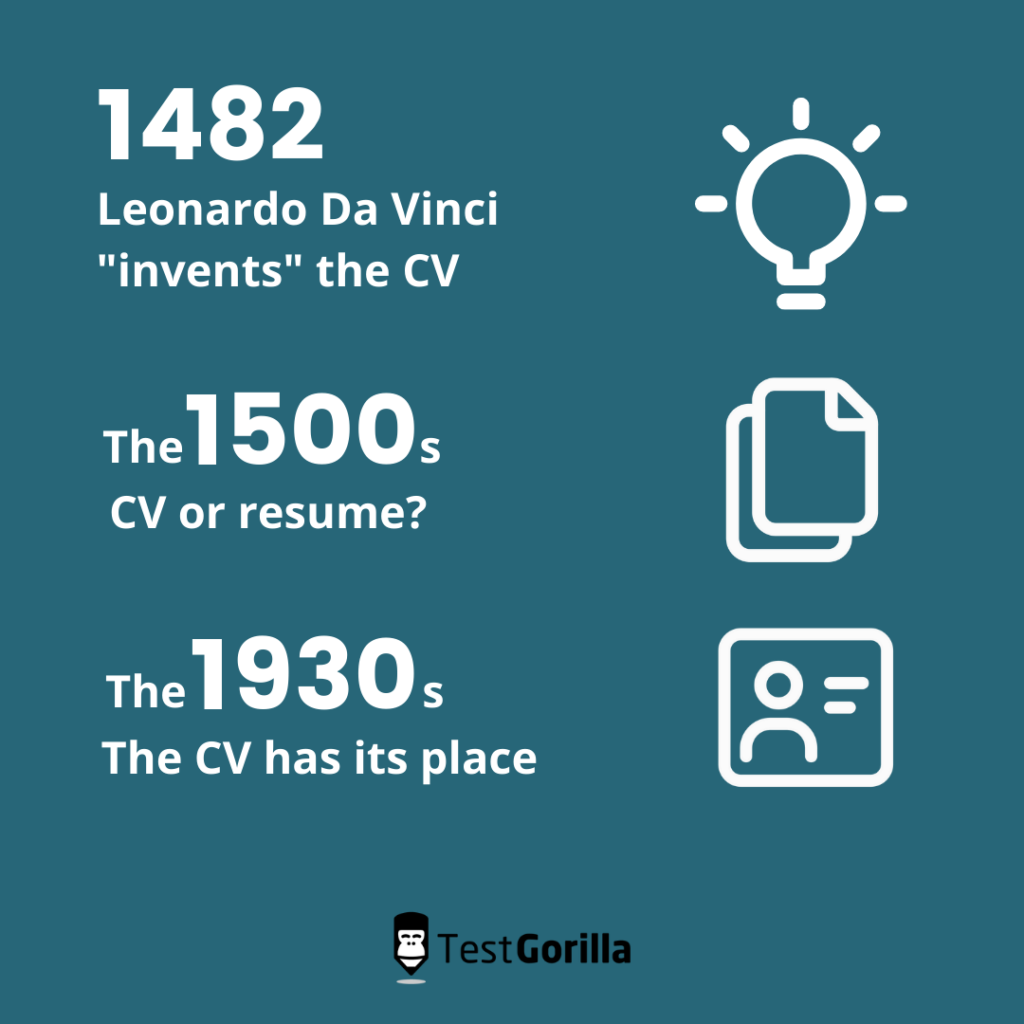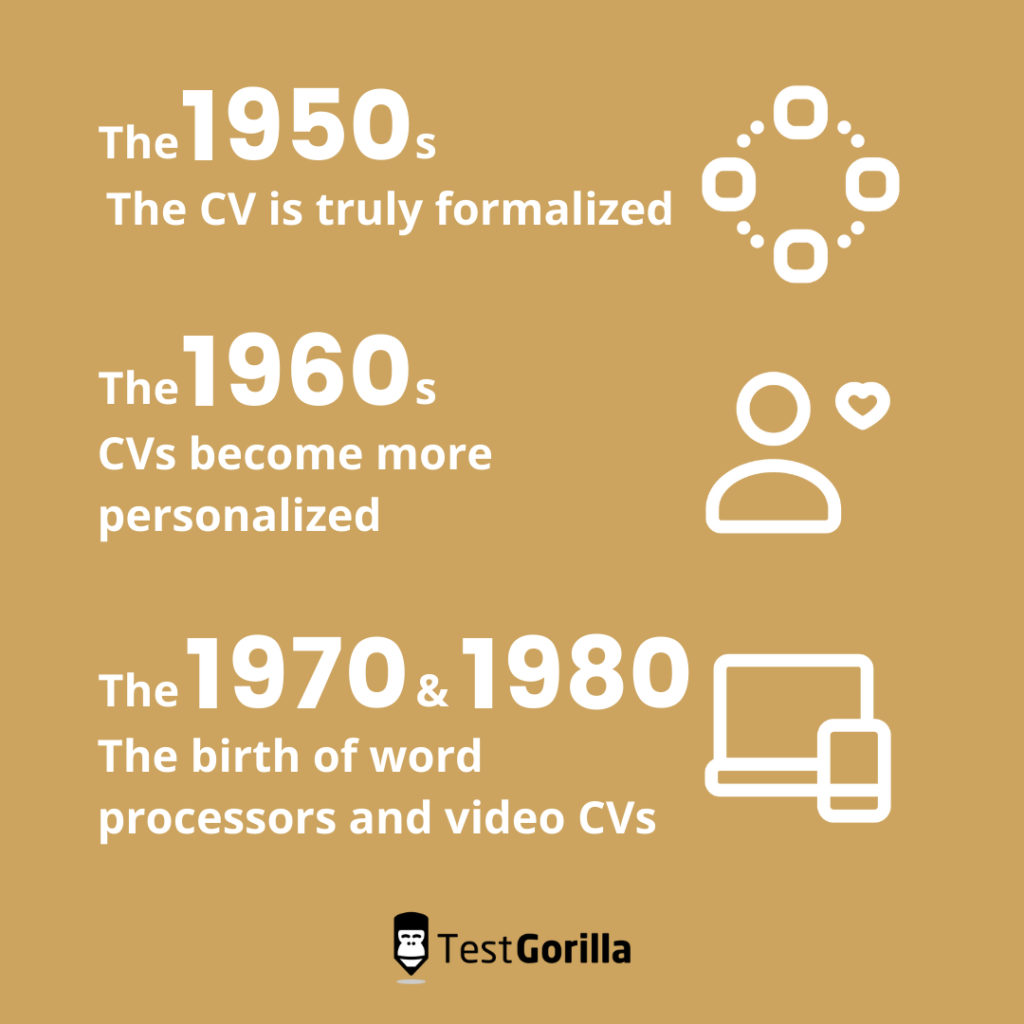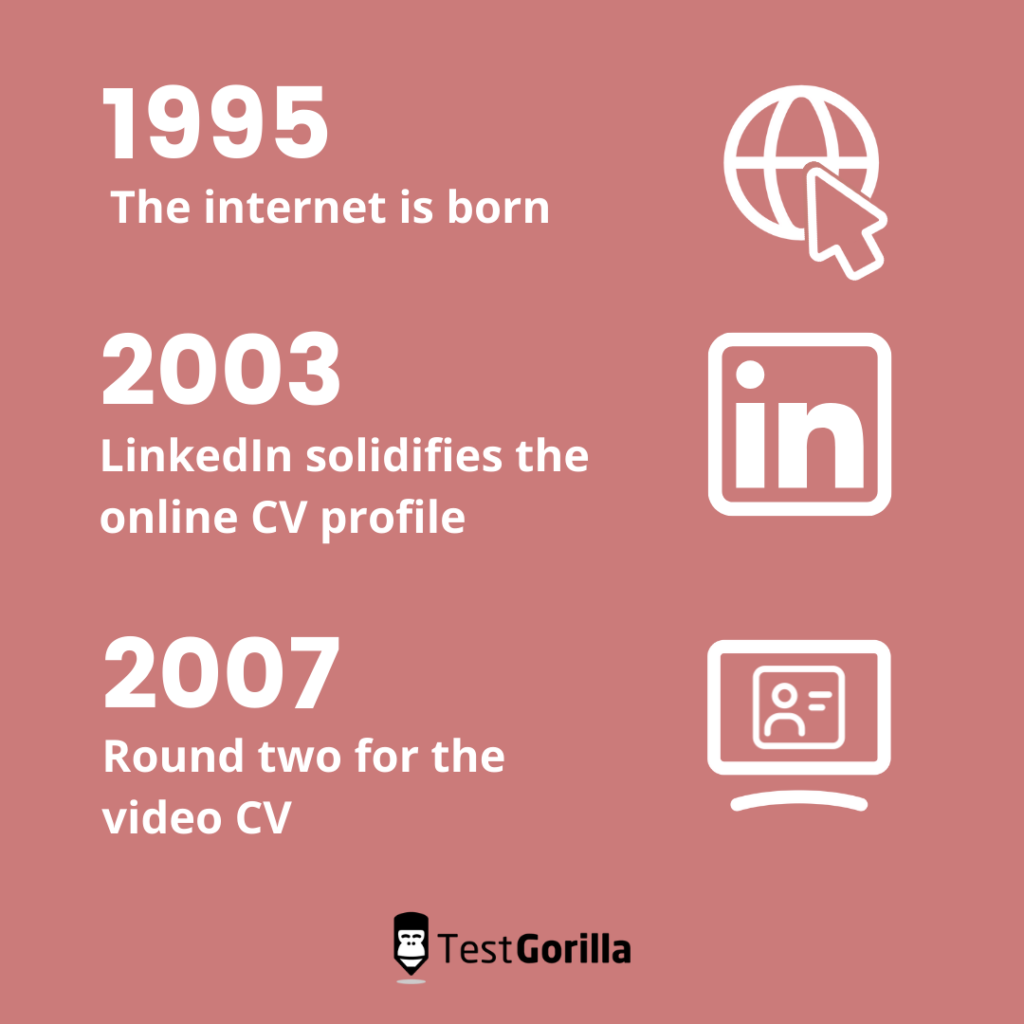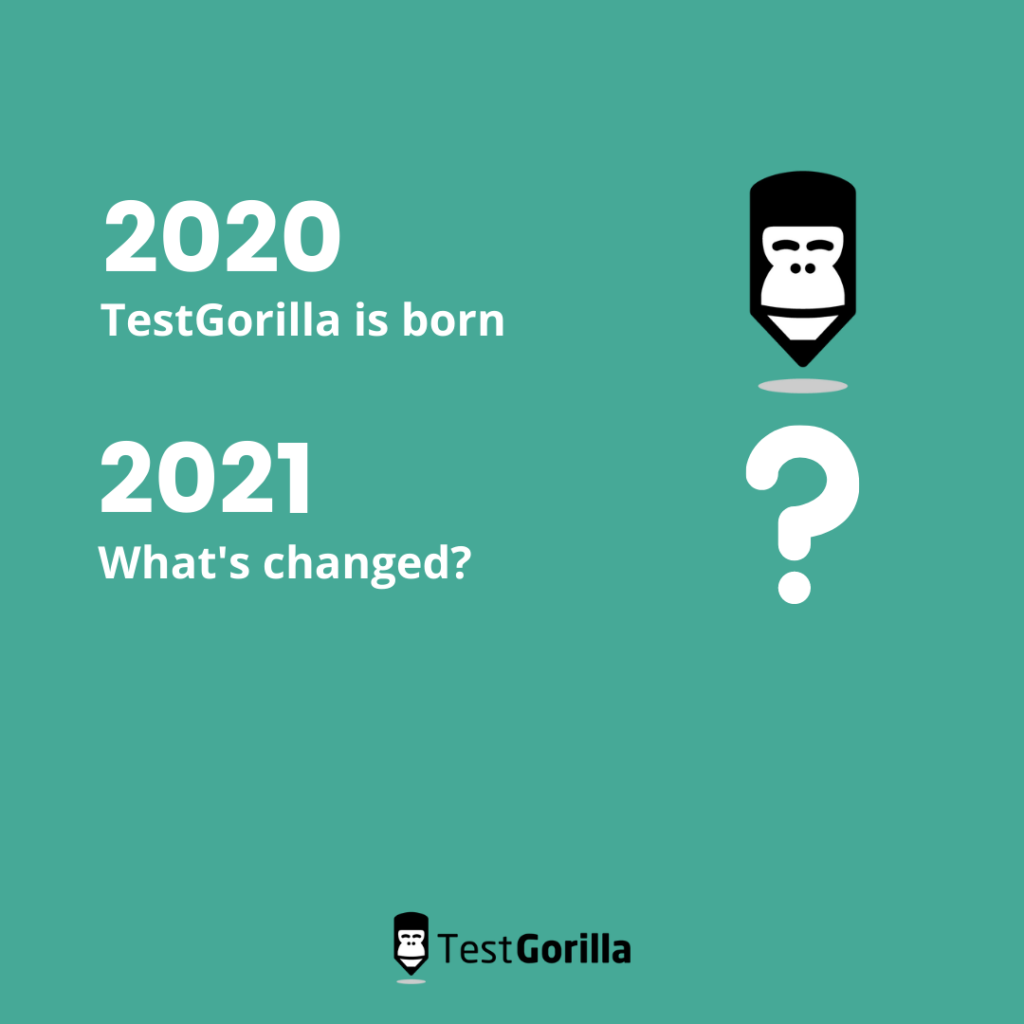The history of the CV and the future of hiring
As a recruiter or hiring manager, parsing CVs and resumes is likely your least favorite task. Where some CVs are too short, others are too long. Where some reflect the fact that the candidate hasn’t read the job description properly, others lack substance and are simply stuffed with keywords in the hopes of catching your eye or getting through an Applicant Tracking System (ATS).
In other words, sifting through CVs can be a minefield. What’s more, CVs only provide you with two pieces of information: education and job experience. While these are important to know about, they’re not the only factors contributing to a great hire. So why is the history of the CV still being written?
Unfortunately, despite massive technological advances in the business world, recruiting and hiring processes have remained pretty stagnant. The traditional CV as we know it hasn’t changed much over the years, and this approach to recruiting and hiring is laborious, ineffective, and expensive.
No data suggests CVs help hiring managers make great hiring decisions. So, why do companies insist on relying on the archaic CV?
Here, we explore the history of the CV, the problems of the modern CV, and what future recruitment approaches we can expect to see.
Table of contents
A brief history of the CV
The traditional CV is even longer in the tooth than you might think. Let’s dive into the history of the CV and see how recruitment got stuck in the CV cycle.
1482: Leonardo Da Vinci “invents” the CV
Not content with creating some of the most famous pieces of art and designing the first parachute, Leonardo da Vinci is also credited with writing the first CV as we know it.
In 1482, in search of work, he allegedly penned a letter to the Duke of Milan outlining his skills and experience. He offered his services in designing bridges, building boats, and sculpting, among many other things.
And thus, the CV was born.
The 1500s: CV or resume?
While most would say CVs and resumes are the same, some dispute this. Those who do, believe that resumes are more of a one-page document that briefly outlines a candidate, while a CV can run over many pages.
In the 1500s, it’s alleged that a Lord traveling throughout England offered people a letter of introduction, dubbing it his “resume.”
The 1930s: The CV has its place
Fast forward to the 1930s, and the CV has become a regular part of the world of work. However, CVs in this era were little more than notes made during interviews or meetings rather than a prerequisite for a job.
The 1950s: The CV is truly formalized
During this era, CVs were expected more often than not as part of the job application process.
Employers also requested your age, weight, and parents’ backgrounds on each CV – plus a “professional” picture of you wearing formal workwear.
The 1960s: CVs become more personalized
By this time, candidates had started to bulk out their CVs with information on their hobbies, likes and dislikes, and other personal information to help them stand out from the competition.
The 1970s and 1980s: The birth of word processors and video CVs
With the introduction of word processors, typed CVs became more standardized, meaning no more trying to read everyone’s handwritten scrawl. Then, candidates who really wanted to set themselves apart started mailing cassettes with their video CVs to potential employers.
1995: The internet is born
Not long after the world wide web was born, online job resources and directories quickly sprung up, helping jobseekers find many more potential employers than ever before – and send out many more CVs too.
2003: LinkedIn solidifies the online CV profile
Often hailed as the nail in the coffin of the traditional CV (which, as we know, was not the case), LinkedIn offered candidates and recruiters a new way of networking, connecting, and showcasing both jobs and candidate CVs.
2007: Round two for the video CV
YouTube brought video CVs back to life again, giving candidates a chance to showcase their personalities and work experience.
2020: TestGorilla revolutionizes pre-employment testing and puts an end to outdated CVs
With pre-employment testing, CVs are no longer necessary and are becoming obsolete. Employers can now pre-screen candidates with the help of online skills assessments, which allow companies to select candidates based on their actual skills instead of on diplomas, exaggerated competencies, or work history.
2021: What’s changed?
With the growth of online job boards and the internet in general, companies turned to Applicant Tracking Solutions (ATS) to help sift through the multitudes of CVs they received. However, that’s really where the history of the CV and its evolution ends.
Although job applications and candidate screening have changed, companies still request up-to-date CVs with a chronological list of work experience, education, and other relevant skills.
5 Problems with the modern CV as we know it
By looking at the entire history of the CV, we can see that despite massive technological changes, companies as a whole are still heavily reliant on CVs when assessing candidates for new open roles.
Broken down, CVs are nothing more than documents that (often) blandly describe a person’s job history and experience. Given that a recent study showed that almost 80% of people have admitted lying on their job applications, should CVs really be the be-all and end-all when hiring?
False information is just one problem with the modern CV. Let’s take a look at five other issues that should persuade anyone in recruitment to consider different ways of assessing candidates.
There’s no common standard for CVs and resumes
If there’s one thing that no one’s agreed on, it’s how CVs and resumes should be formatted, what information is deemed necessary and unnecessary, and what level of details should be included.
The CV is meant to serve one purpose: to find out exactly how suitable, qualified, and experienced the candidate is for the relevant position. But if there’s no common standard, how level is the playing field? While some companies want to know about your hobbies, others won’t give a second thought to CVs listing personal interests.
Recruiters and hiring managers are essentially baselessly judging candidates. Even though many companies ask candidates to fill out an application form (which would be unnecessary if there were a standard CV format) with specific questions, each candidate is left to their own devices when crafting their CV.
Some of us are better than others when it comes to selling ourselves on paper – which doesn’t necessarily mean we’re the right candidate for the job, rendering CVs pretty pointless.
Experience is not always a good predictor of new hire performance
Multiple studies demonstrate no strong link between someone’s work experience and their performance in a new role. So why do we rely so heavily on a static, chronological list of someone’s past work experience to assess whether they’re the right person for the job?
Ultimately, while someone might have the “perfect” work experience profile, it has no bearing on their potential performance at your company. There are several reasons for this. They might not fit in with the culture at your company, they might not have the right skill level, or they might not have the right skills at all (after all, how would you know if you don’t test candidates before you hire them?).
Used alone, they’re a lazy hiring practice
This is a hard truth that recruiters and hiring managers need to face. Even though you’ll eventually move candidates to the interview process to assess them further, sifting through CVs is undeniably the easiest (and yes, laziest) option when it comes to first impressions. Relying on CVs to make critical hiring decisions often results in poor hiring matches.
Rather than judge applicants from a static piece of paper, ask them to take one or more pre-employment tests. The results of these tests – whether a language test or a test that assesses programming skills – will help you more accurately identify high-caliber talent than a CV ever could.
They often don’t accurately reflect the candidate’s abilities
Whether a candidate has embellished the truth a little, or whether they’ve researched the position so well that they’re able to build a CV that reflects the perfect profile, how can you really know what a candidate’s abilities are without testing them objectively?
Alternatively, an applicant might be the perfect candidate for the role, but because their CV looks or reads a little bland, you might dismiss them from the outset. Or you might write them off because their work experience or background is a little unconventional.
In short, unless you test candidates’ skills beforehand, you won’t know until you get to the interview process whether a candidate has massively over or undersold their abilities.
They’re open to hiring bias
It’s an unfortunate fact that unconscious bias is always at play during the hiring process. As humans, we’re prone to be swayed by certain details and information about others, which is only exacerbated when we only read about that person from a piece of paper.
In a famous study conducted by The American Economic Association, it was shown that candidates with “white-sounding” names received callbacks almost 50 percent more often than candidates with “African-American-sounding” ones. Multiple studies show that men and women are twice as likely to hire a male candidate over a female one.
Even details such as which university the applicant attended, their previous employers, and their personal interests can unconsciously influence decisions made by recruiters and hiring managers.
What does the future hold for recruitment, and how does the CV fit in?
A few questions are surrounding the future of the CV. Are they still valuable in today’s highly digitized job market? Will companies tire of them? What could disrupt the CV-centric recruitment world as we know it? Let’s get into it.
Although CVs arguably still serve a purpose for recruiters and hiring managers, it’s impossible for candidates to effectively showcase their professional and personal identity, skill set, work experience, hobbies, and interests via the traditional CV format.
Companies who have already tired of CVs have turned to ATS solutions to help them manage the recruiting cycle. Yet, these organizations could still be missing out on top talent through the digitized parsing process.
So, what’s the alternative?
Job-relevant pre-employment testing complements any CV or job application and should come before the resume/CV review process. Asking applicants to show rather than tell you what their skills are and how proficient they are in each gives you a much higher chance of distinguishing a good candidate from a great candidate.
It’s also near-impossible to get a feel for an applicant’s personality, emotional or social intelligence, or interpersonal skills via their CV. Personality and culture tests such as an Enneagram test or 16 Types test will give you a fully rounded view of each candidate to ensure they’re the perfect fit.
A new era in hiring and recruitment
The history of the CV is coming to an end. Static CVs can’t compare to the data and information you can glean from pre-employment testing. Shortlisting candidates should be based on facts rather than a CV that regurgitates the same information repeatedly.
For example, two candidates could have near-identical employment histories, skills, and educational backgrounds. Without pre-employment testing, how can you genuinely differentiate each candidate profile without bias?
Pre-employment testing helps create a transparent, streamlined, and reliable way of shortlisting candidates. In short, with the rise in data-driven HR functions, the CV will become secondary to predicting real-world job performance with a solid pre-screening process.
Related posts
You've scrolled this far
Why not try TestGorilla for free, and see what happens when you put skills first.
Latest posts
The best advice on pre-employment testing, in your inbox.
No spam. Unsubscribe at any time.

Hire the best. No bias. No stress.
Our screening tests identify the best candidates and make your hiring decisions faster, easier, and bias-free.
Free resources
This checklist covers key features you should look for when choosing a skills testing platform
This resource will help you develop an onboarding checklist for new hires.
How to assess your candidates' attention to detail.
Learn how to get human resources certified through HRCI or SHRM.
Learn how you can improve the level of talent at your company.
Learn how CapitalT reduced hiring bias with online skills assessments.
Learn how to make the resume process more efficient and more effective.
Improve your hiring strategy with these 7 critical recruitment metrics.
Learn how Sukhi decreased time spent reviewing resumes by 83%!
Hire more efficiently with these hacks that 99% of recruiters aren't using.
Make a business case for diversity and inclusion initiatives with this data.





















